I guess part of me has always been an explorer.
No, not that kind of capital "E" Explorer - I haven’t discovered new lands, walked off the map, completed bold first ascents or any of that headline-grabbing stuff. But, I’ve been fortunate enough in my travels and adventures to wander off the beaten path somewhat, to explore terrain that, if not new to the world, is new to me, unfamiliar in all ways, be it on Everest’s North Face, the slopes of Gurla Mandhata, my own back yard, or elsewhere.
Our venture up the Hunku Khola from Chheskam to Kongme Dingma was just such an exploration. Sam and I and our team were not in uncharted waters; if we’re being honest, there is little in Nepal outside the extreme alpine realm that has not seen the feet of a herder or the staff of wandering ascetic over the ages. No, the Hunku is well known to the Kulung Rai and other locals, but not so to the outside world. I know of only a handful of people who have been up there before, one being Tim Macartney-snape, and if you know him and his history he’s not one for following the known path. So on December 6, we headed off into the somewhat unknown.
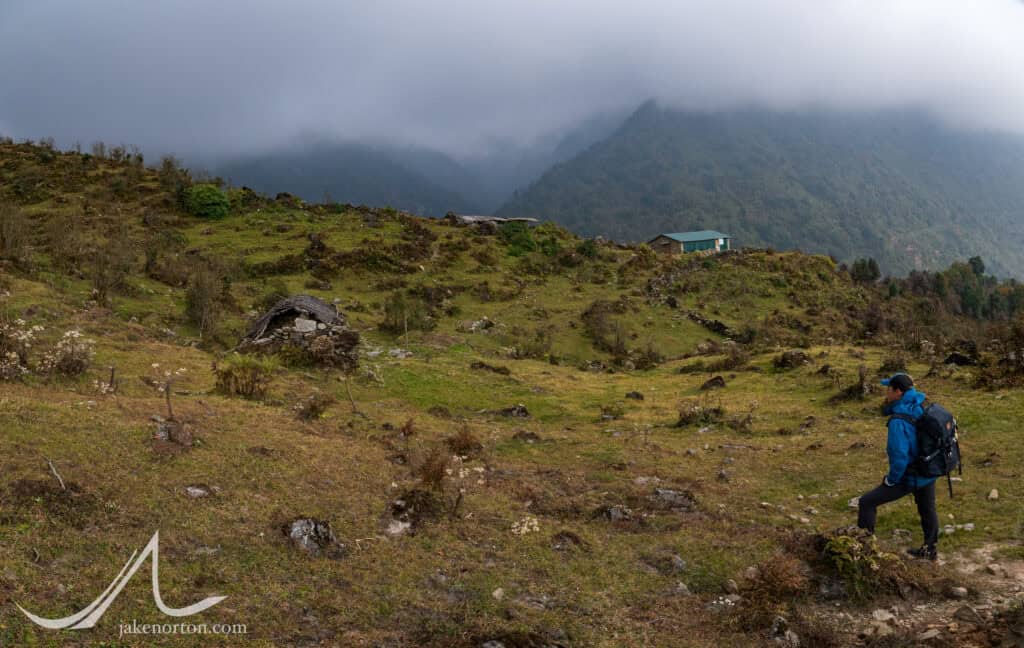
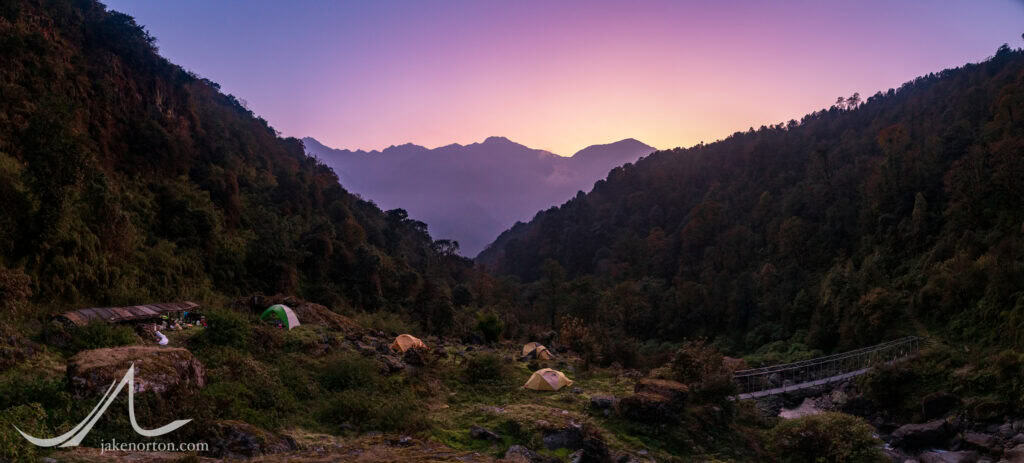
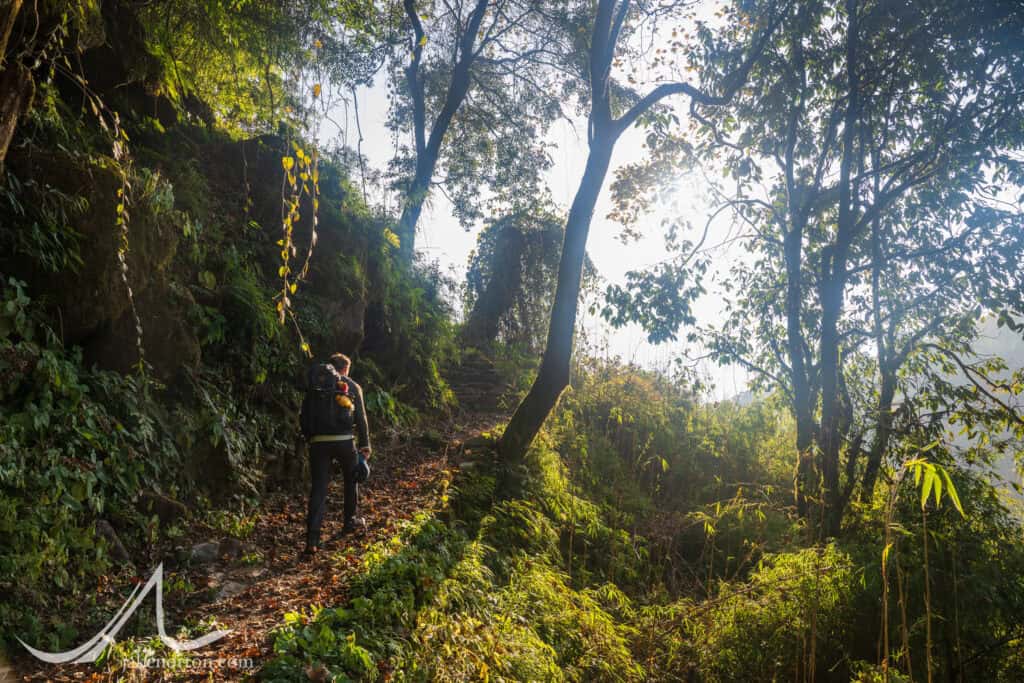
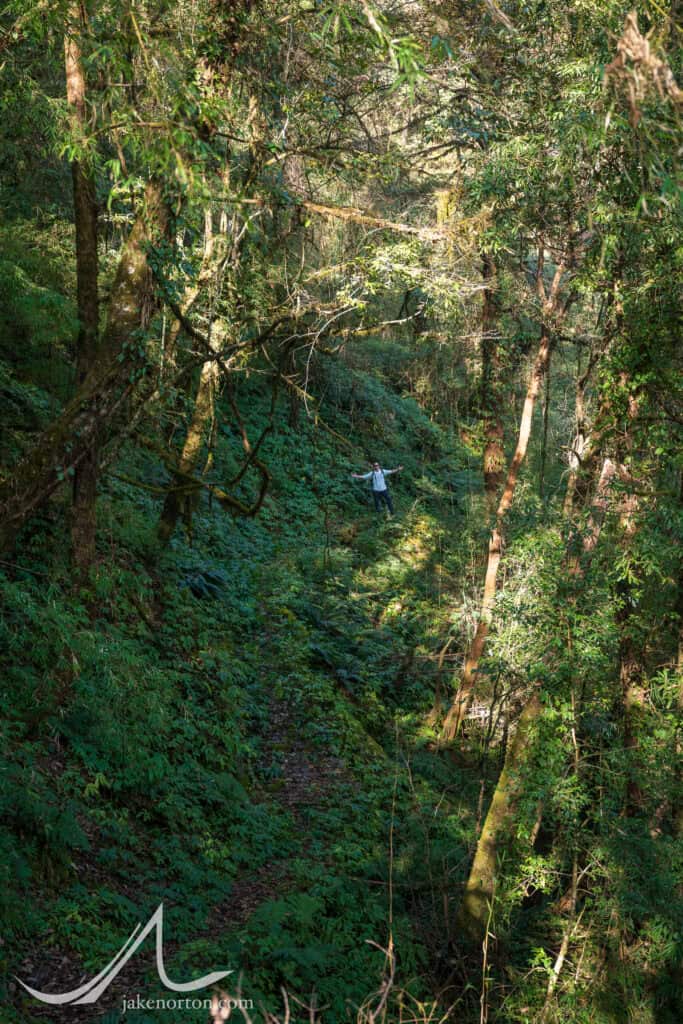
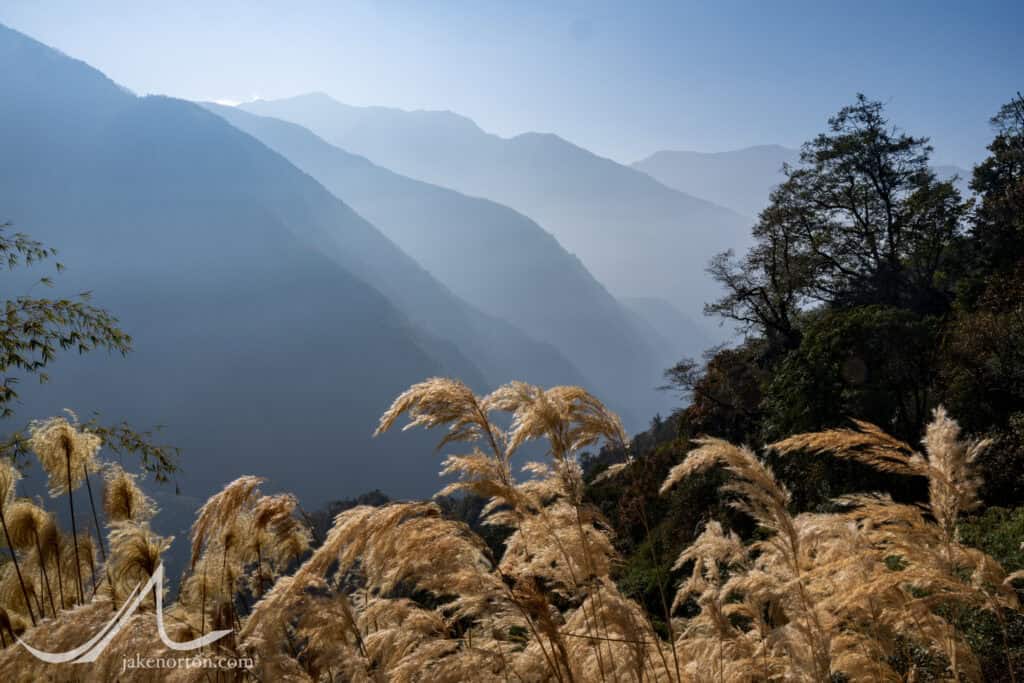
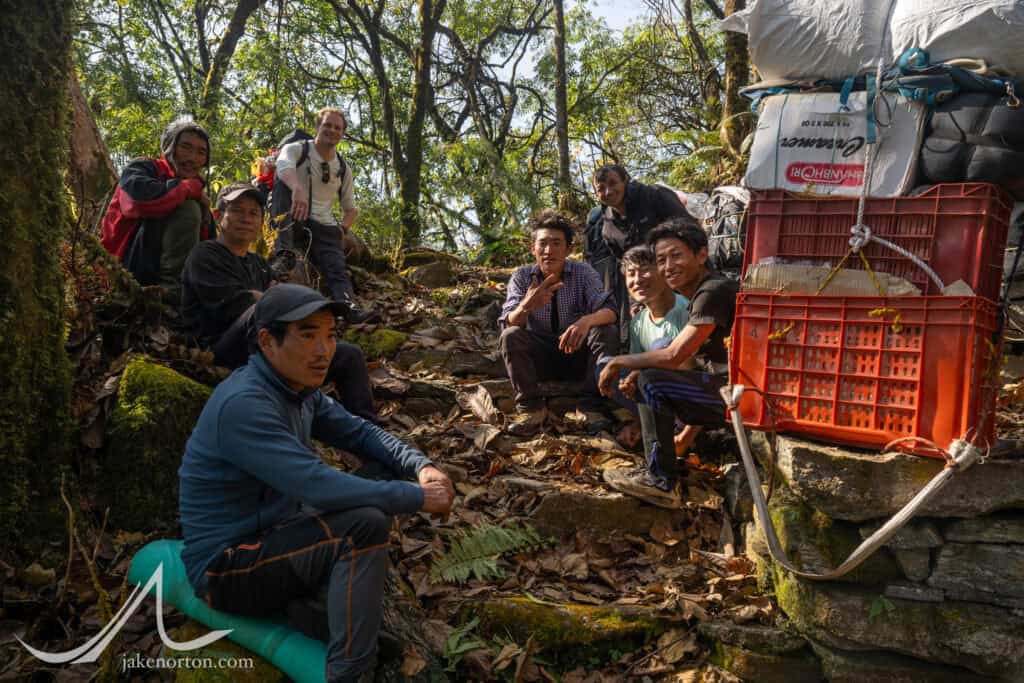
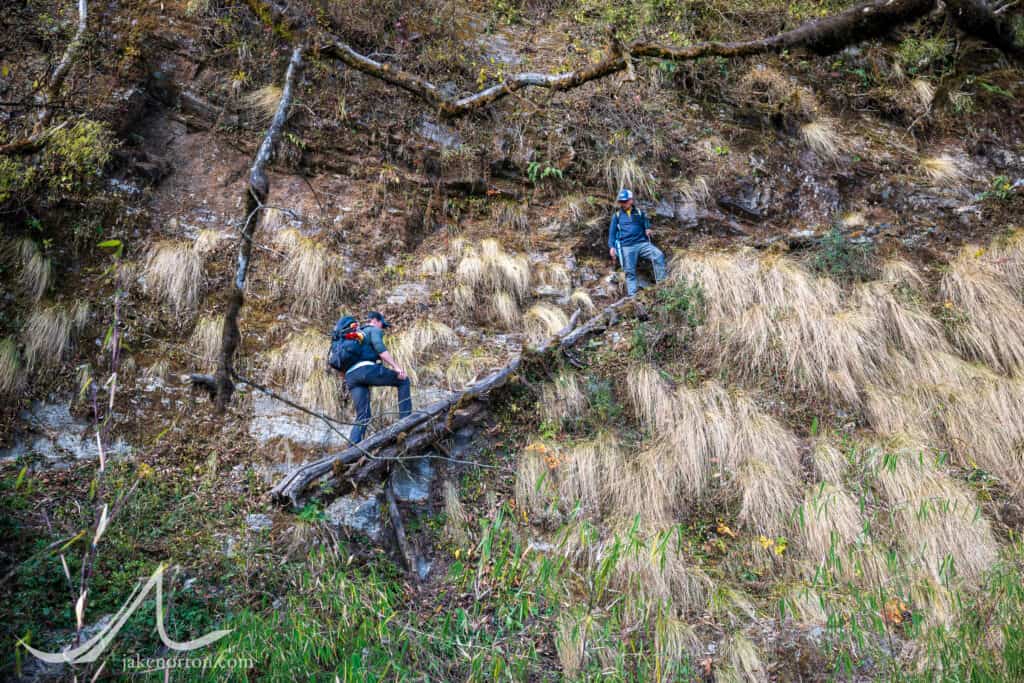
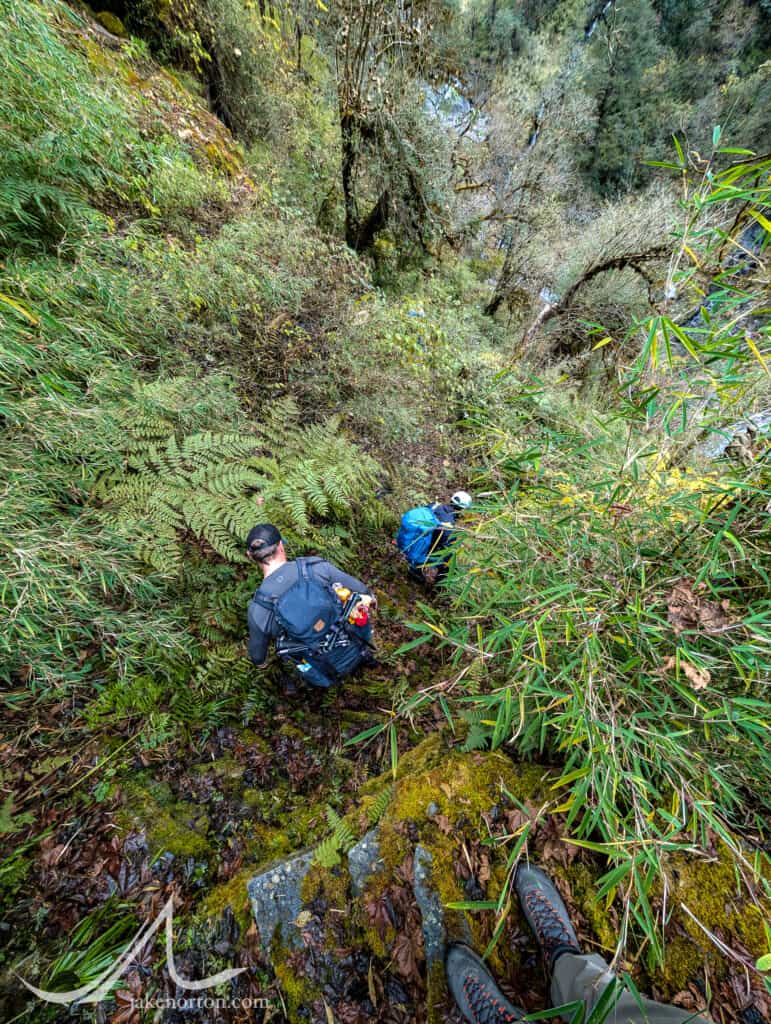
The new trail - dubbed by the excited community of Mahakulung as the Mahakulung Muddhi-Kongmedingma Trail - follows the Hunku Khola as it roars through a narrow canyon of its own creation. Unlike many treks in the Nepal Himalaya - and quite different than its nearby neighbor, Khumbu - this trail ambles through dense jungle, towering forests of East Himalayan Fir (Abies spectabilis), Musure Katus (Himalayan beech, Castanopsis tribuloides), Bull oak (Quercus lamellosa), Himalayan birch (Betula utilis), and rhododendron (both falconeri and arboreum). It’s a misty place as well, with afternoon cloud wafting up the valley, enshrouding the landscape in mystical ether turning to ethereal ice during the night.
While the Hunku finds its source up high in the melting ice of the Hunku Glacier on Baruntse and the alpine lakes of Seto Pokhari and Paanch Pokhari, its power is fed downstream by countless tributaries large and small, azure cascades coming down from numerous unnamed 5,000 meter peaks and larger, named ones like Naulekh and Mera. Thankfully, the municipalities of Mahakulung (Gudel, Bung, and Chheskam) built bridges across most, ranging from simple trusses to deluxe covered bridges and simple sticks-on-rocks for yet others still.
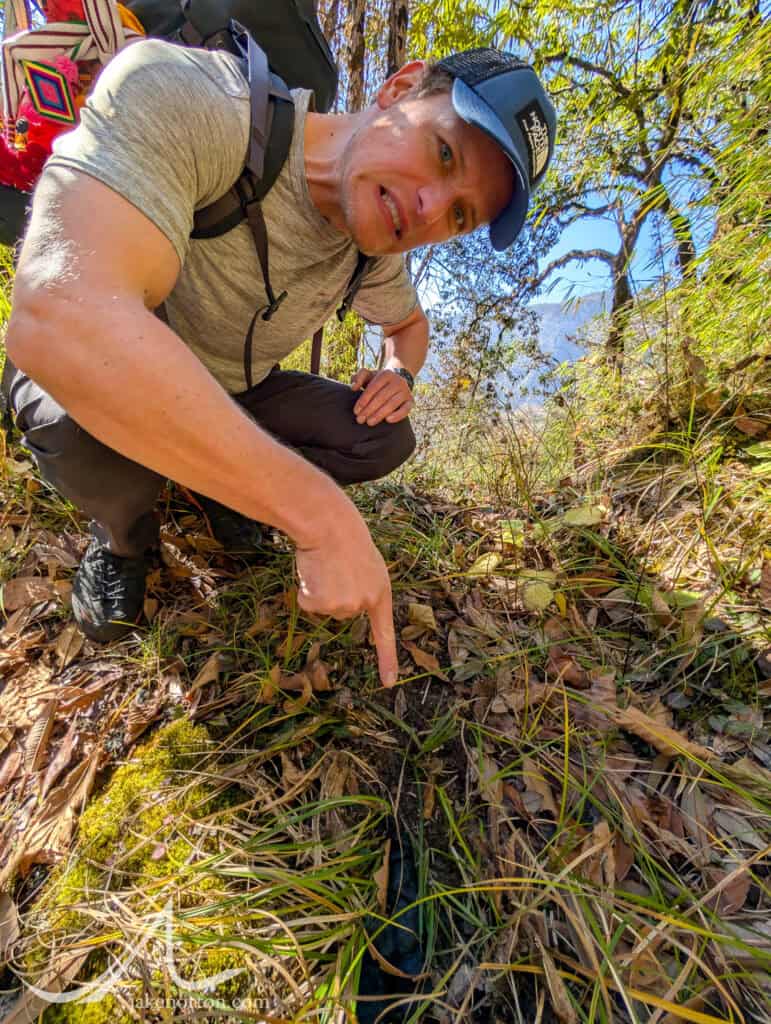
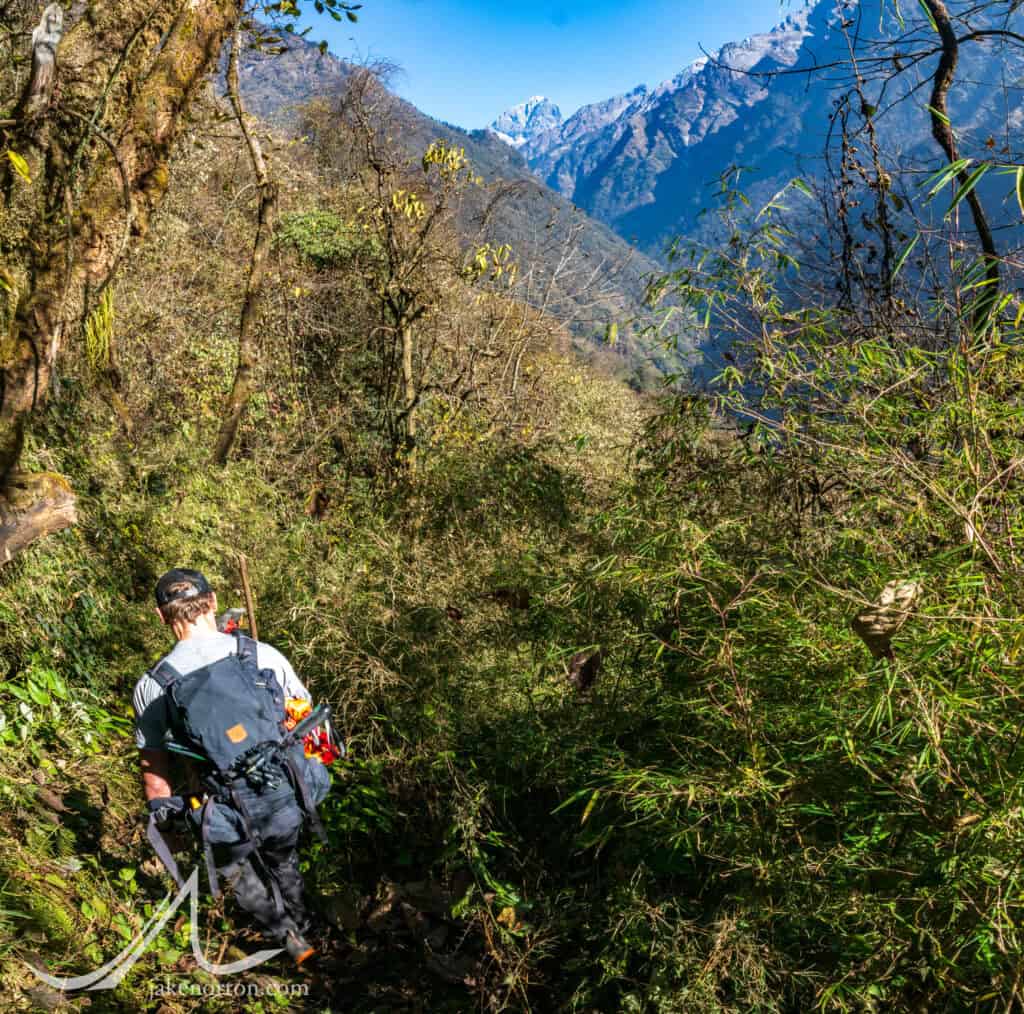
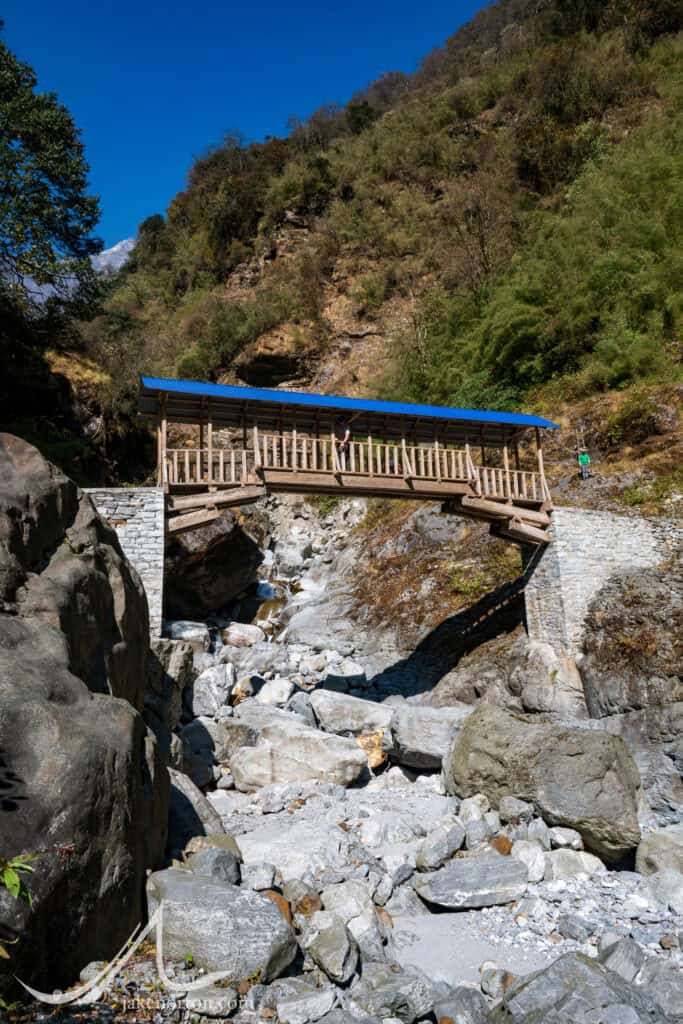
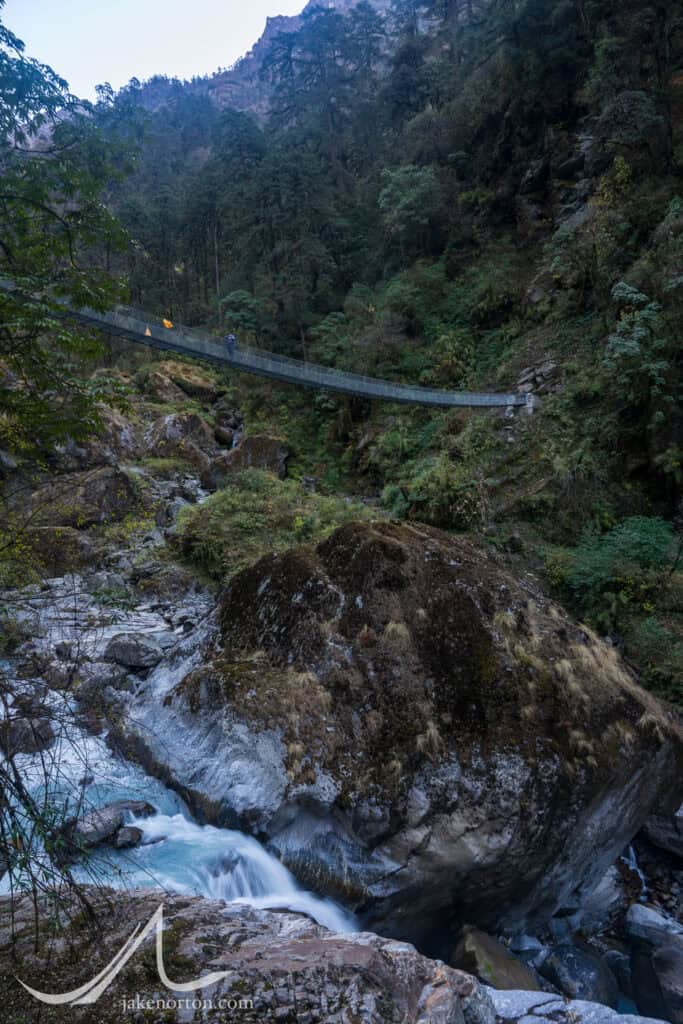
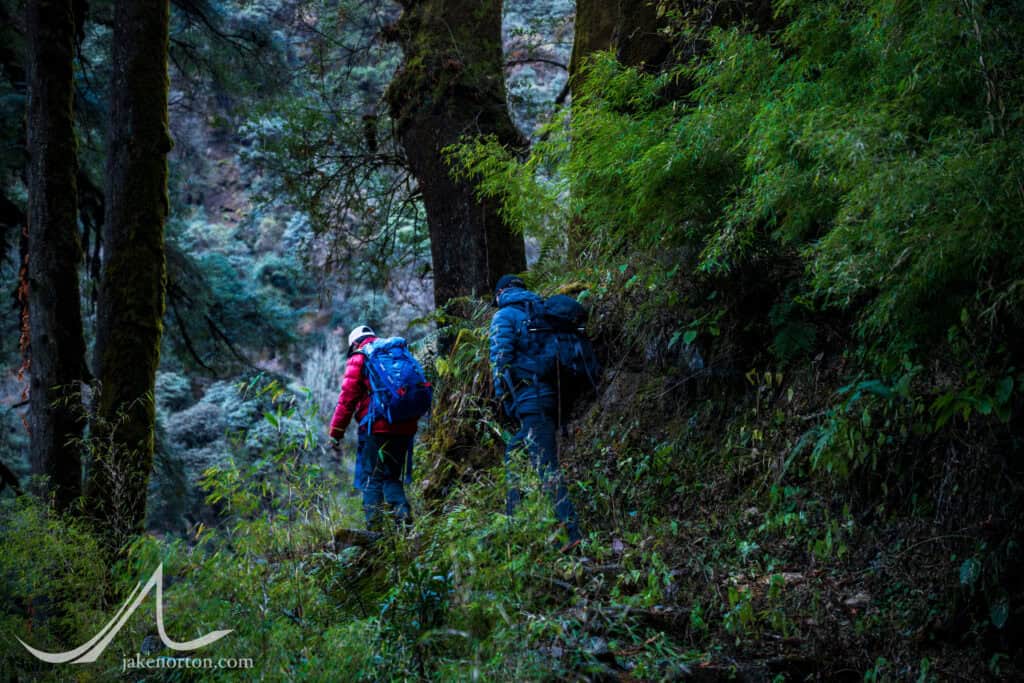
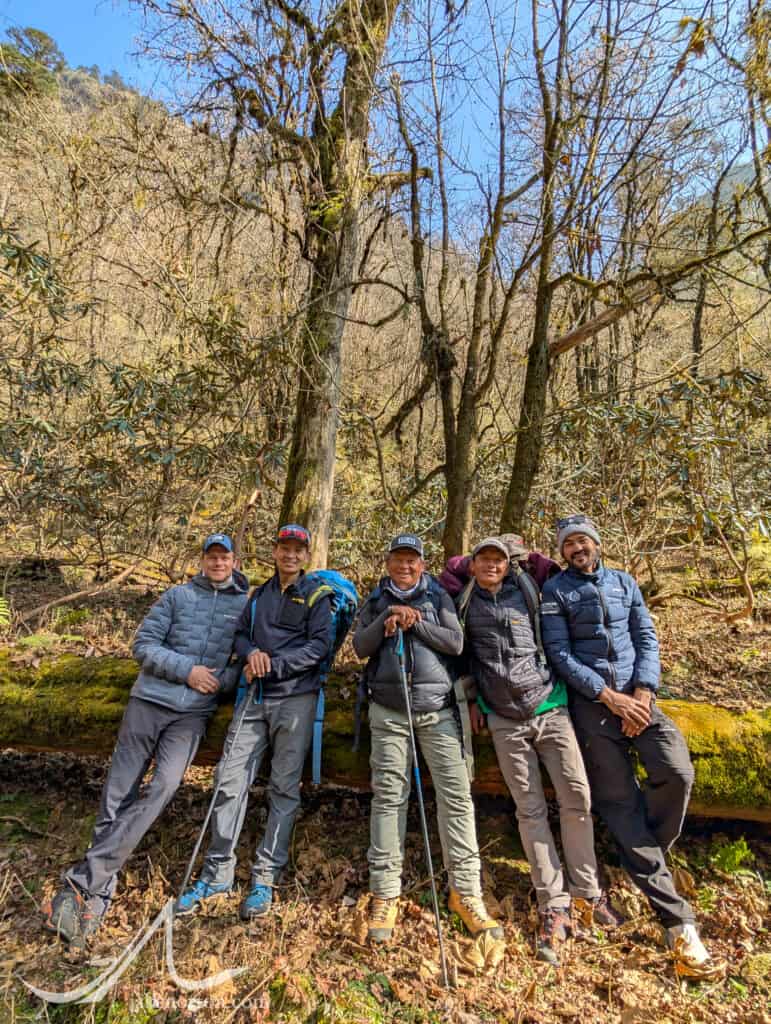
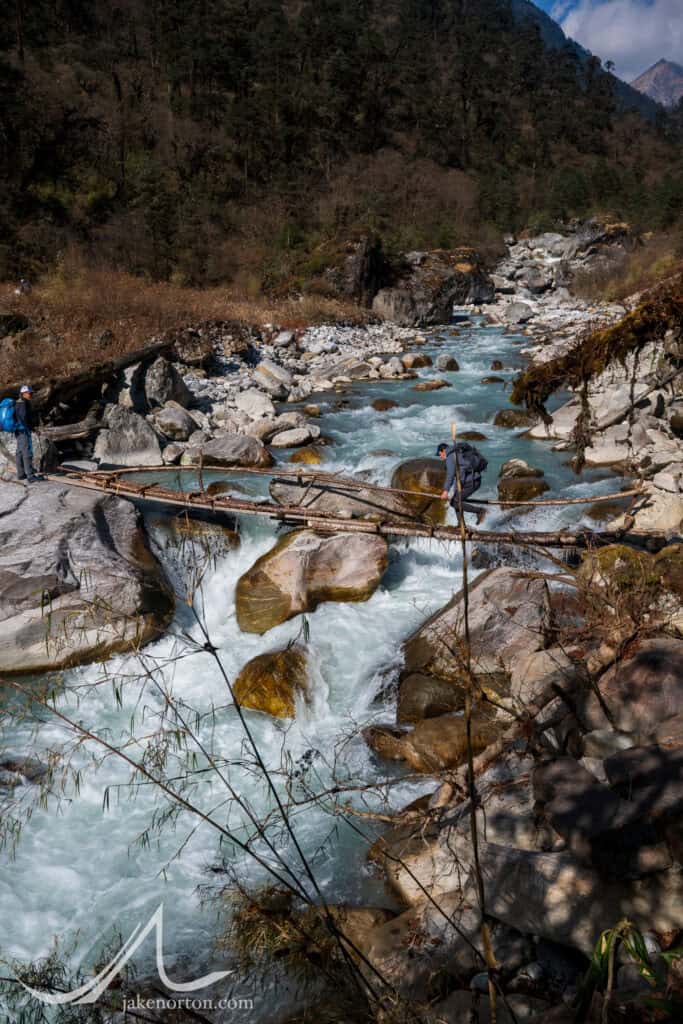
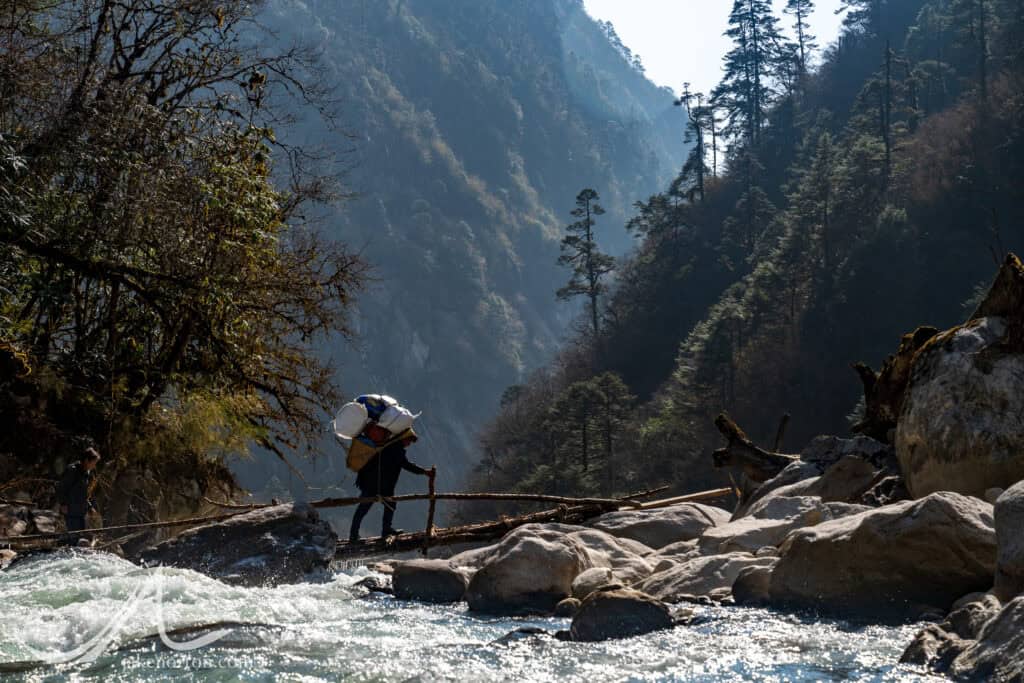
Our trail - choked at times with bamboo or slick with mud, glazed with ice - meandered along the Hunku’s path. Folded as they are, the Himalaya do not lend themselves to easy trails, however, and the Muddhi-Kongmedingma is no exception: a straight line from Point A to Point B is rarely possible, with Ridge C and Valley D more often standing in the way. While most days the trail had a net gain of about 1500 vertical feet, we’d easily double that with ups and downs along the way.
But, that’s not to say days were hard; they were, taken all together, about perfect. Much of that is thanks to our team, and wonderfully motley crew of folks helping schlep our gear and prepare meals and keep us company along the way. And, this being the first real commercial trip up the valley, we never knew with certainty where the next flat ground would be found and if it would have water nearby. So, some days were cut short, some were stretched longer. Vagaries of the valley forced the abandonment of one acclimatization day at Watelma Chaur, but to little consquence: we were nimble, Sam was strong, our team able.
Six days of fairly magical, mystical trekking took us through climatic zones from forest to alpine, through sun and snow and ice, mornings of frost to afternoons of heat and frigid nights tempered by a blazing fire. We found scat from jungle cats (Asiatic wildcat? Maybe, but quite doubtful.) and leopards (common or snow, we do not know), enjoyed unspoiled nature at its best, and barely a trace of humanity - not a lodge, not a house, not a helicopter or plane. The only person outside our team we encountered until Khumbu was a resourceful Sherpa named Gelu from near Bung who heard of our affinity for both jhway kathe (raksi heated and adorned with sauteed fenugreek) and tongba (fermented millet prepared as a delicious hot drink) and decided we were a good business proposition, hauling several liters of both in his doko up valley. (Note, his instincts proved remarkably correct.)
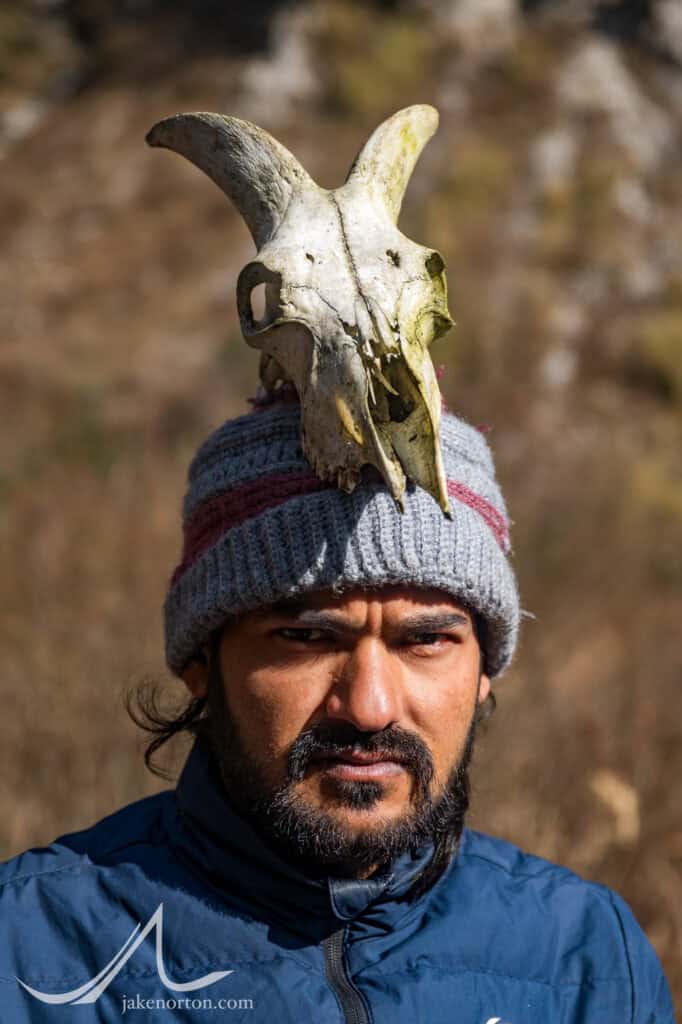
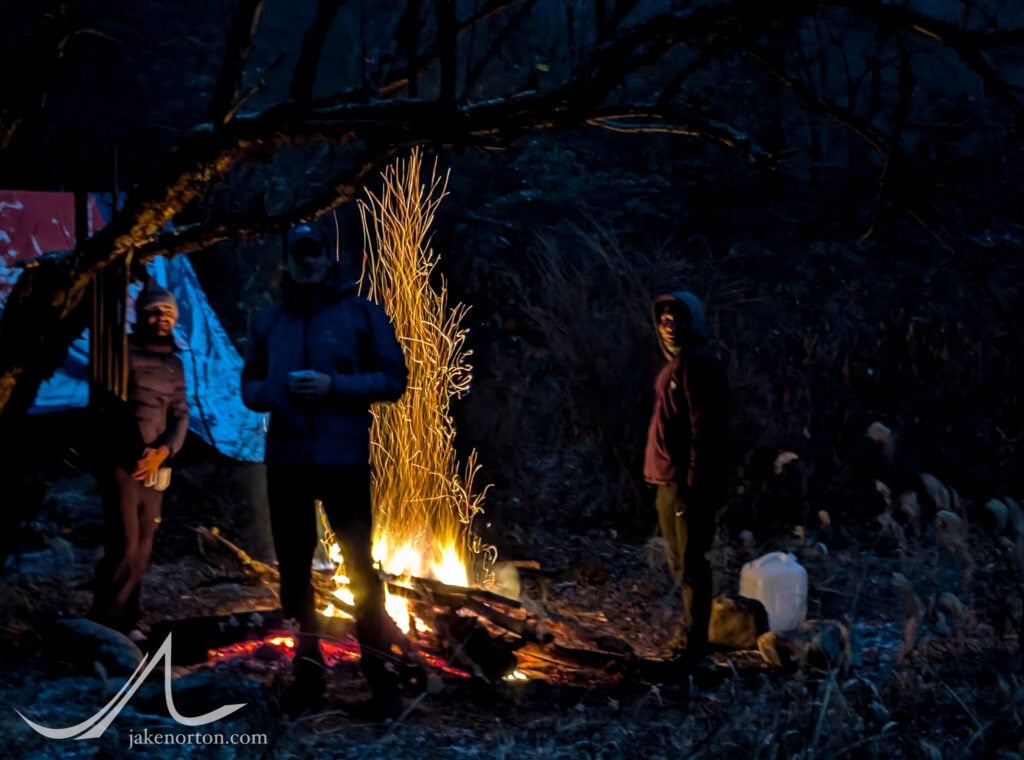
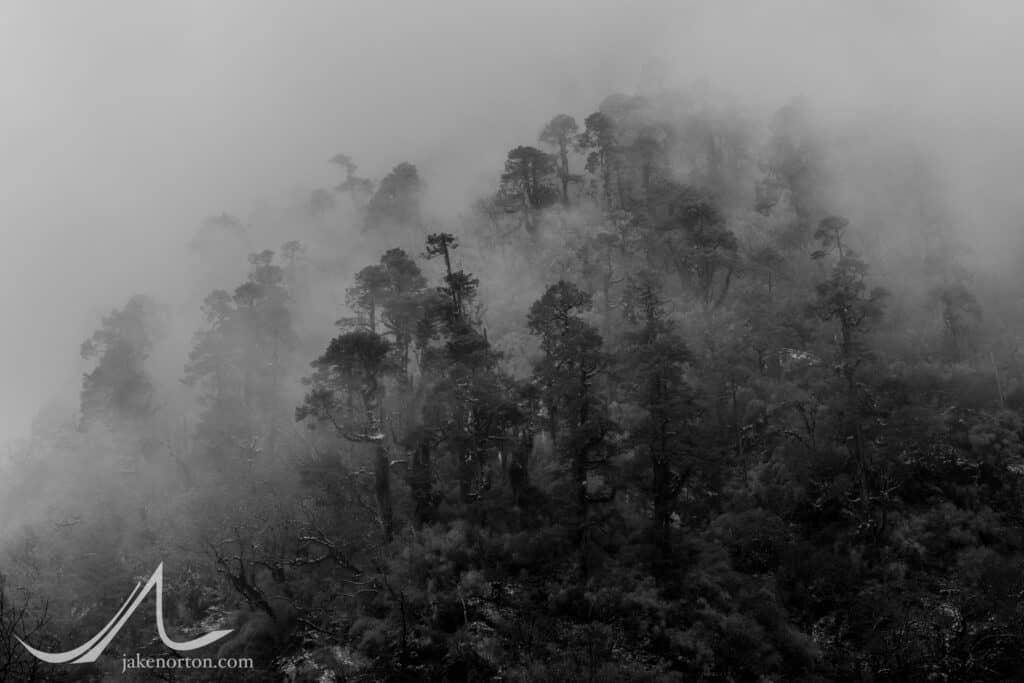
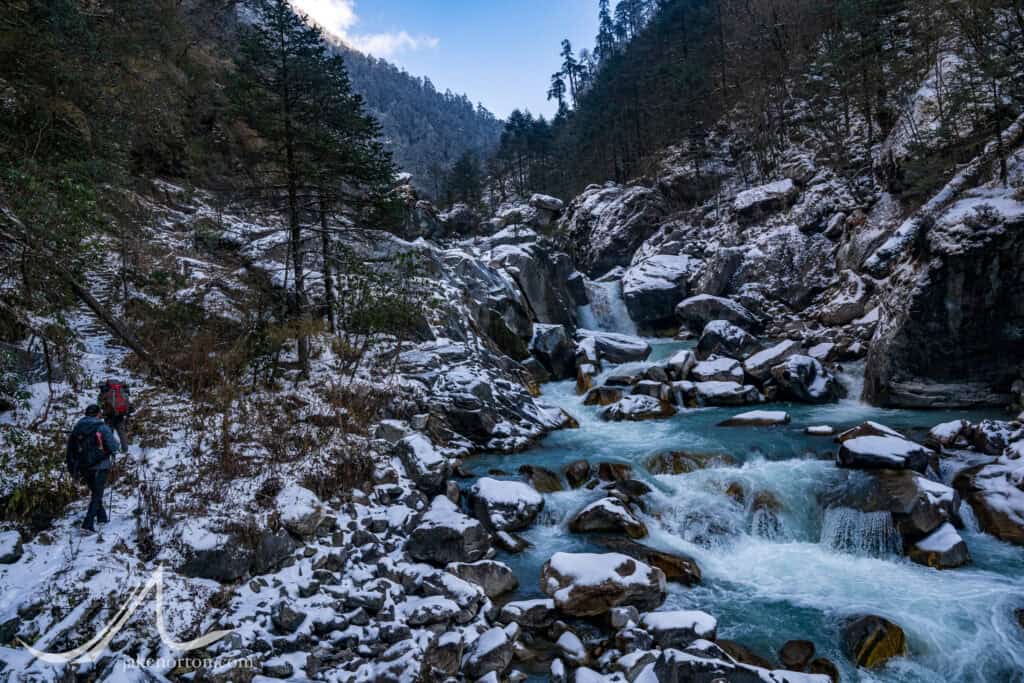

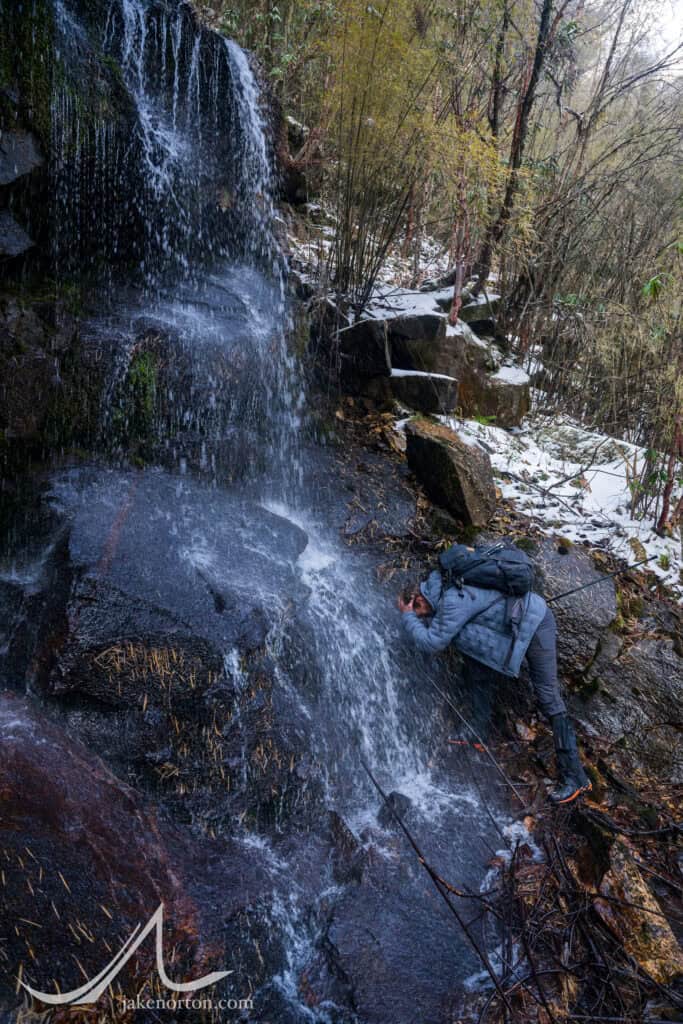
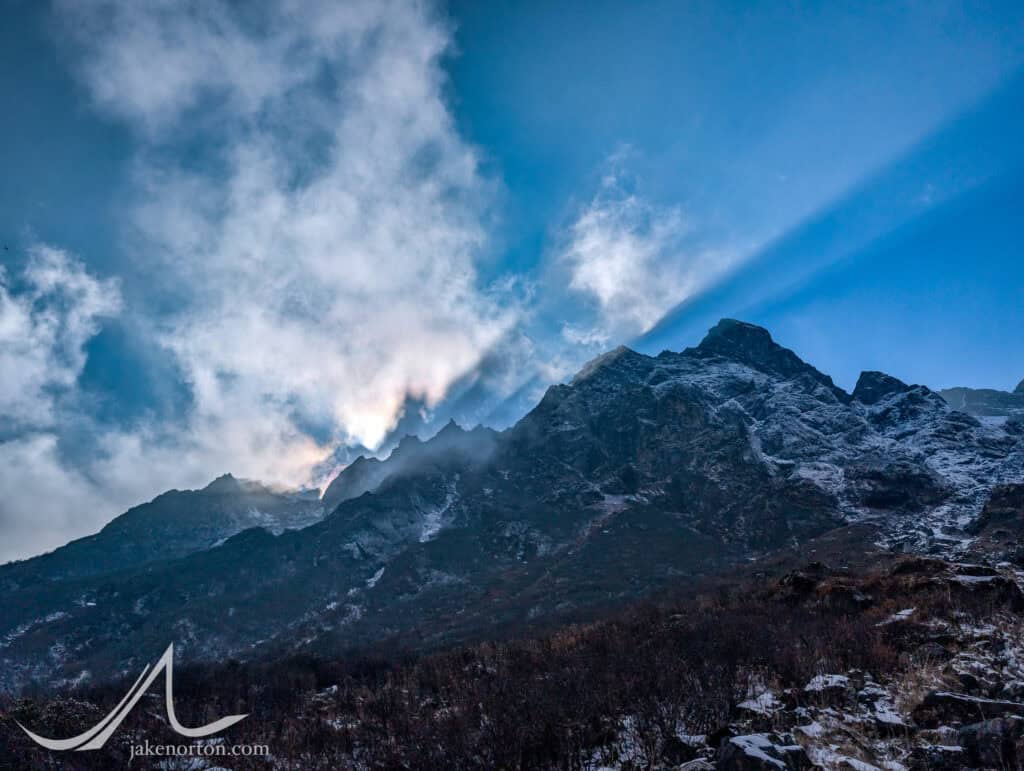
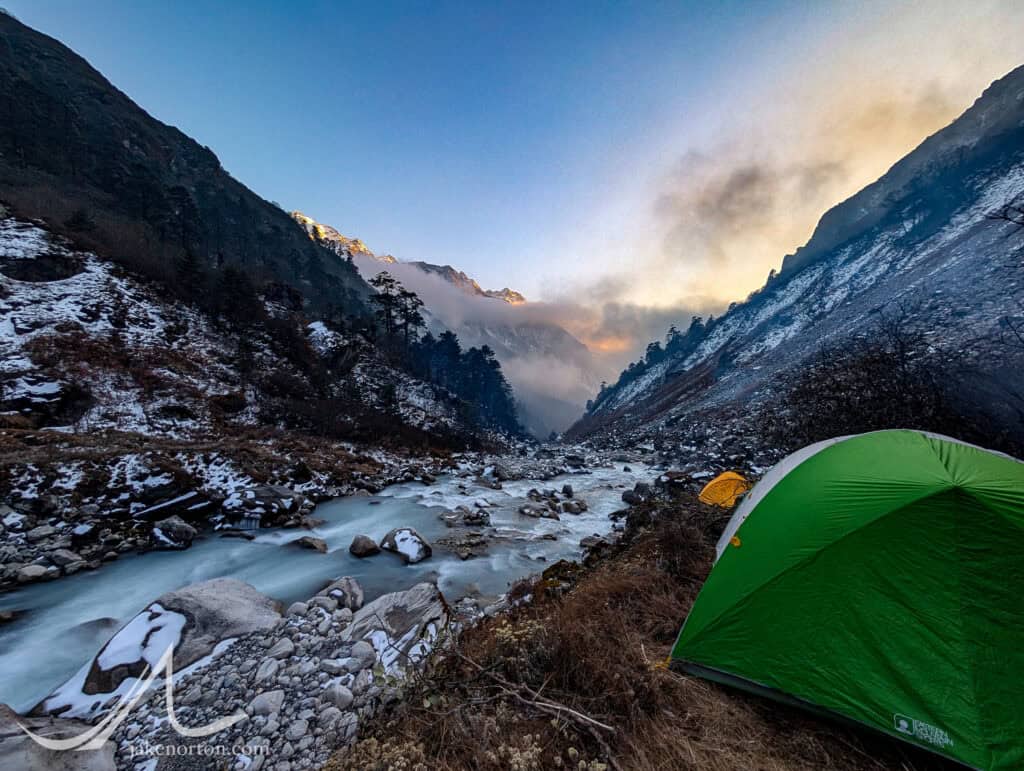
Eventually, we emerged from the forest some 2500 feet below Kongme Dingma and entered the subalpine zone. Here, along with incresingly majestic views of Naulekh and Peak 41 and Chamlang and more, we bushwhacked for an hour through sprawling hillsides of sunpati (dwarf rhododendron, or Rhododendron anthopogon), which is used in most incense from South Asia. So strong and fresh, every step released a burst of aroma making the whole valley akin to walking around Bodhanath during times of prayer. Amazing.
And then, the pain began.
Not bad pain, but certainly some, the hurt of altitude and the cold that comes along with it, the toll extracted physiologically, penance for the privilege of the high country. And, like a first marathon or a first drunk, it hits the uninitiated hardest. We made it to Kongme Dingma, a small, vacant settlement at 15,750 feet, windswept and austere beneath the towering giants of Peak 41, Naulekh, and Chamlang. For Sam and Jhanak, each step of the last 3000+ feet was an altitude record, and inevitably the night brought with it headache and lassitude, the hallmarks up here. But, they fired back with their own hallmarks - grit and positivity.
We spent the night sheltering from demonic, 60 mph wind gusts under Gelu’s tarp-roofed hut. Dung-seasoned dust whipped about as we ate dal bhat, played cards with the team, laughed and talked and smiled and knew that this too would pass, tomorrow would dawn another day.
Altitude is a fickle thing, each person’s specific physiology responding differently to it. Until you’ve been up high, it’s generally a mystery as to how you’ll do, how your body will adapt - or not - to the dearth of oxygen. Some do well, some less so, but most will get it sorted out if given time and tools. Time is the keystone, as the body is working overtime to produce red blood cells and increase hypoxic efficiency; thus, a day off, an active rest day, at Kongme Dingma was essential to let the body do its thing.
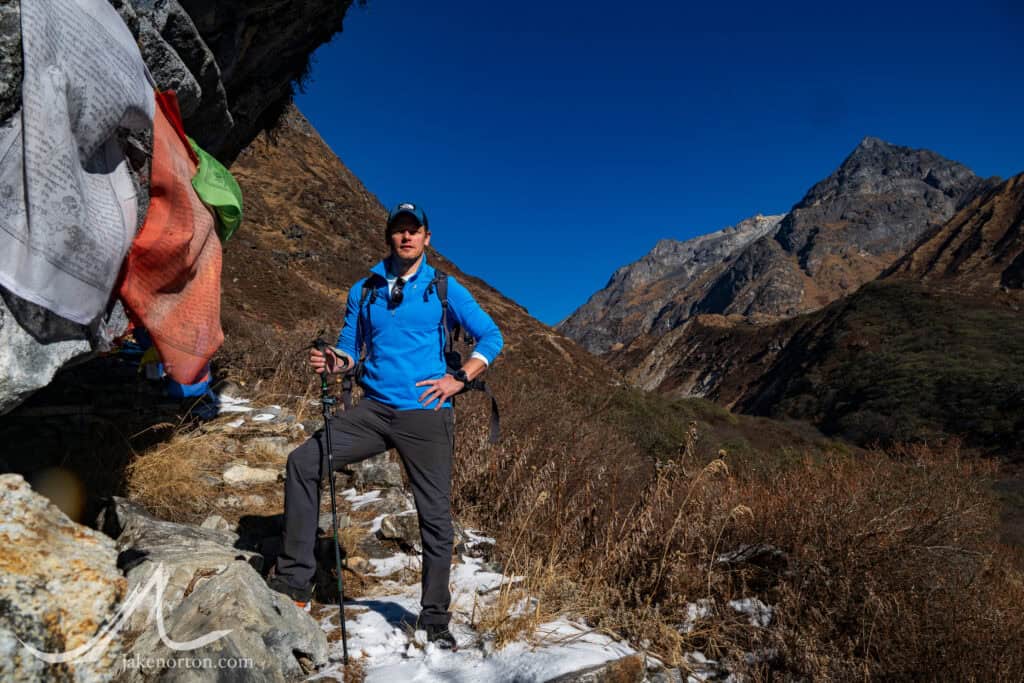
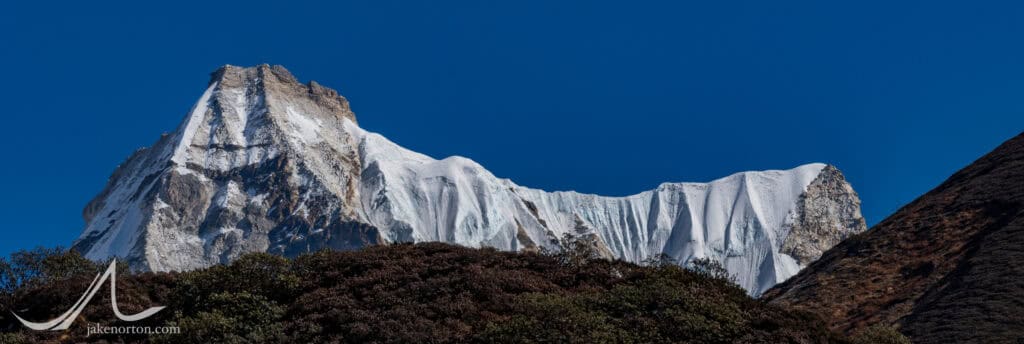
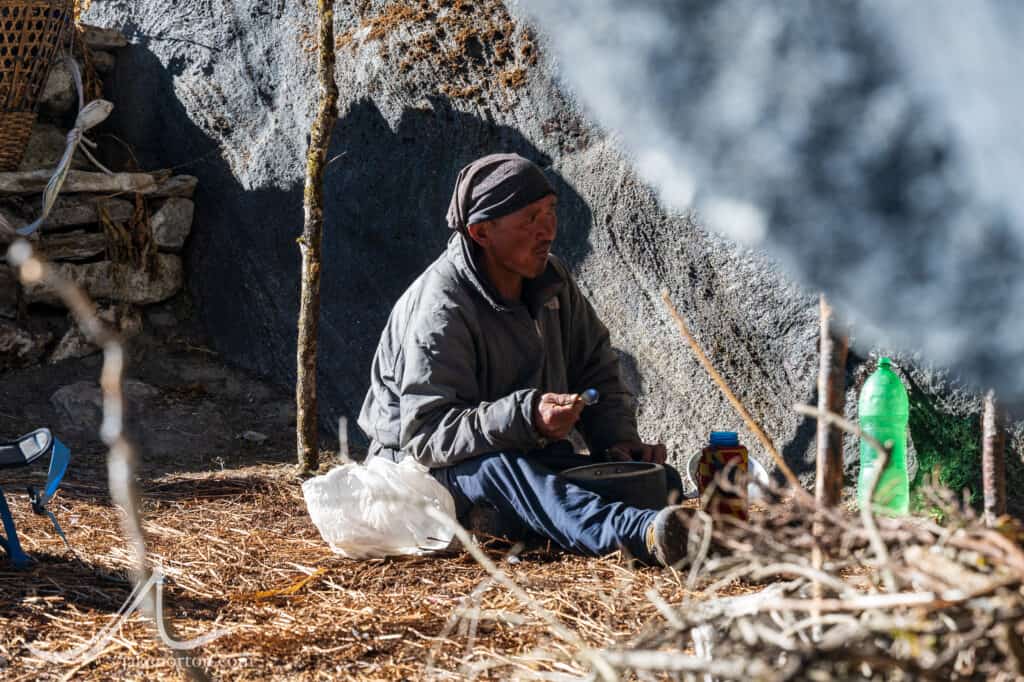
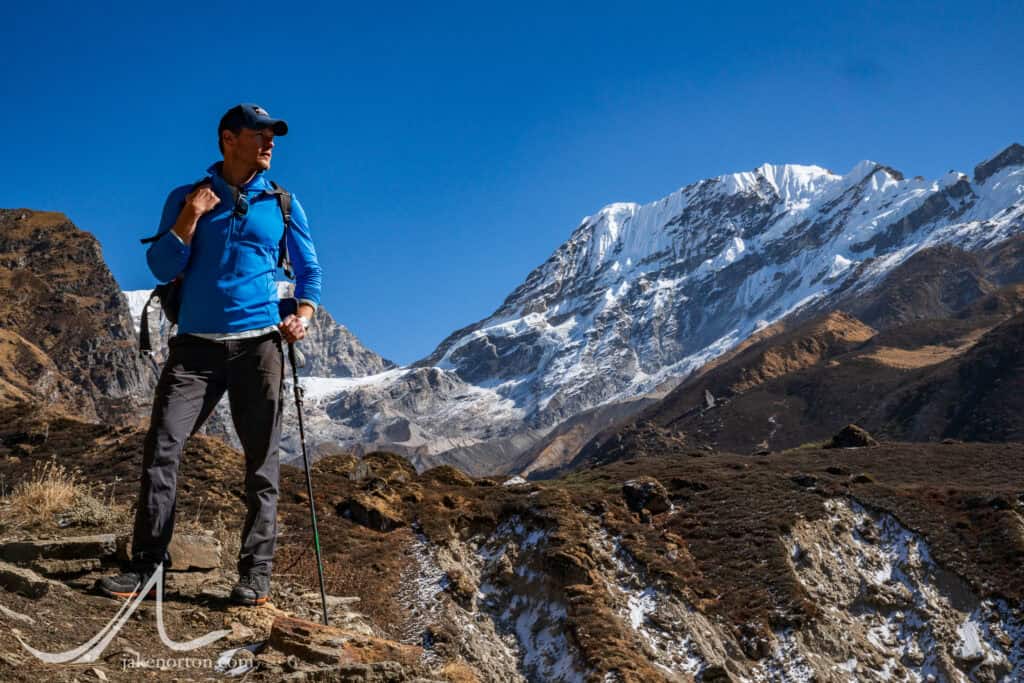
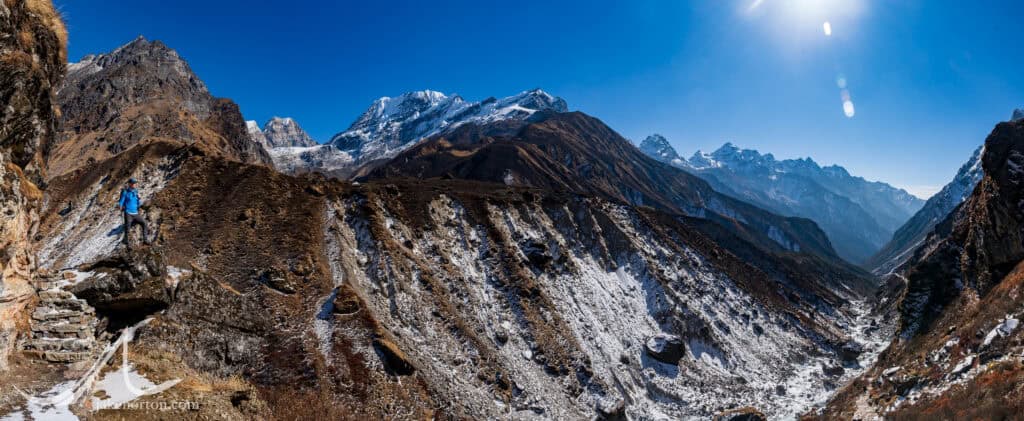
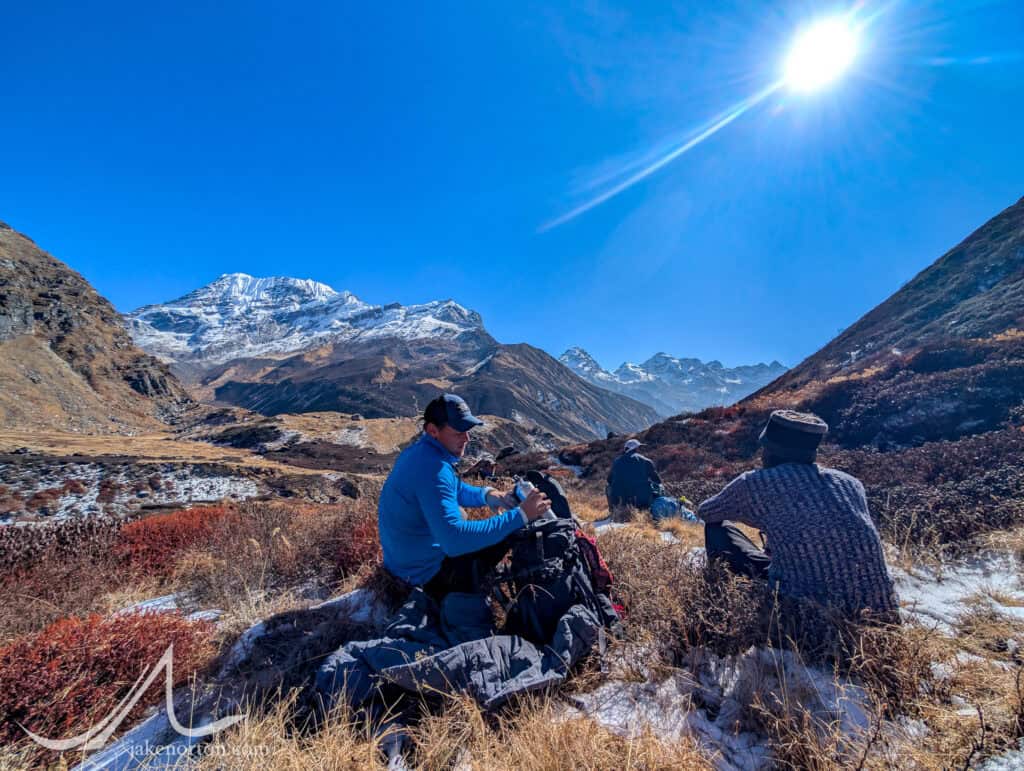
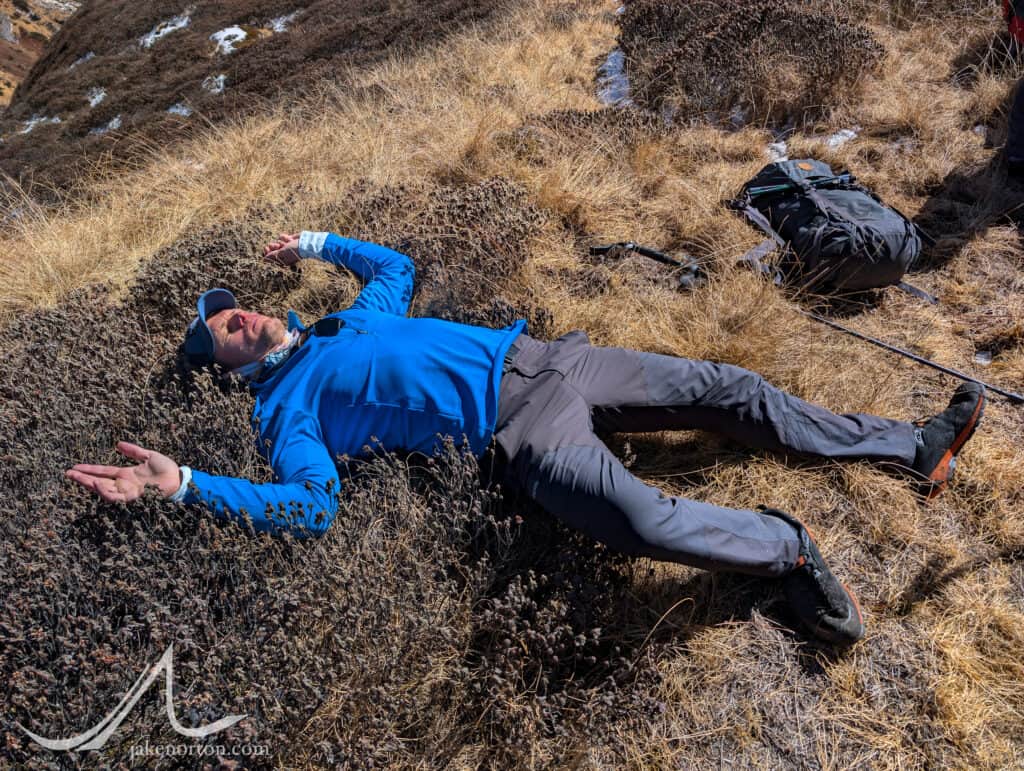
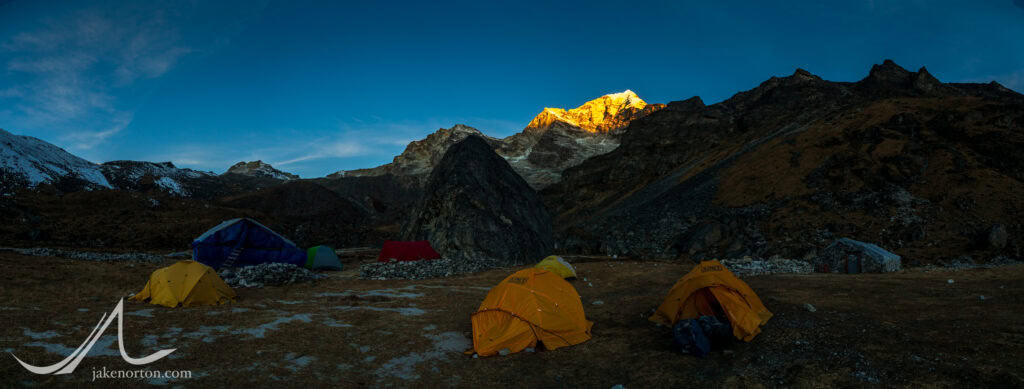
Winds abated, and we spent a stunning day alternating between rest and relaxation, fueling up with copious water and calories, handwashing clothes in icy streams and ourselves as well if we could stand it. Sam, Tshering, and I also spent a couple hours playing on a nearby ice flow, fixing a rope and practicing Sam’s technique with crampons and ice ax, ascending a line and rappelling the same. As expected, he was a natural, making it all seem like old hat, cruising up and down with a smile and confidence seasoned precisely with the right amount of fear and respect for the terrain waiting days ahead on the Amphu Laptsa.
And with that, Part 1 of our trek - the new trail from Chheskam to Kongme Dingma, the Mahakulung Muddhi-Kongmedingma Trail - was finished. The next day we’d enter the alpine, trekking along an established, but seldom used, trail through alpine lakes under serrated behemoths, then up and over the high Amphu Laptsa pass and into the Khumbu. The days before were, as I’d hoped, spectacular, replete with everything a trek in the Himalaya can deliver (but often does not): scenery, solitude, adventure, great company, and memories galore. And, of course, some exploration.
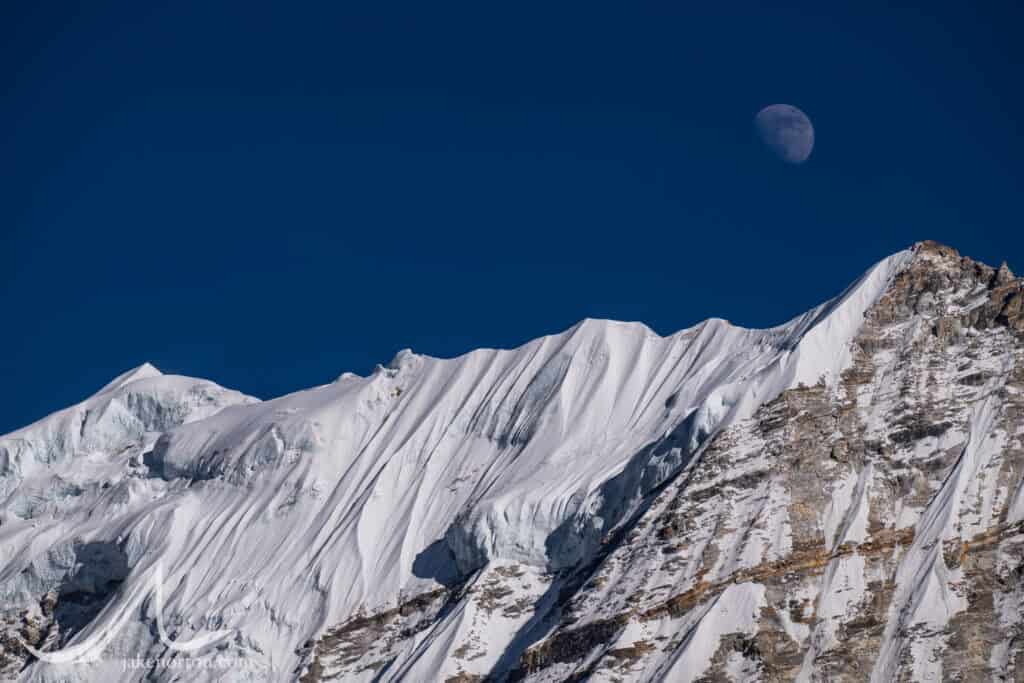
As mentioned above, we didn’t chart new territory, make a daring first ascent, or add new data to the geographic lexicon. But, we did explore, all of us. We explored areas that were new to us, new to most. We explored new ways to help the villages of Mahalulung - and the thousands of souls who live there - develop and establish sustainable trekking and the income that goes with it. And, perhaps most saliently, we explored ourselves, pushing our own boundaries even just a little, probing the possible, exiting comfort zones and finding joy through hardship, toil, laughter, and camaraderie. Like TS Eliot wrote in Little Gidding back in the last century, an ode less to Magellanic exploration and more to that of the personal:
We shall not cease from exploration
And the end of all our exploring
Will be to arrive where we started
And know the place for the first time.
Through the unknown, remembered gate
When the last of earth left to discover
Is that which was the beginning…
- TS Eliot, Little Gidding excerpt from "Four Quartets"
Stay tuned for Part 3 of this story - the Hunku alpine zone, Amphu Laptsa, and Khumbu - coming soon.
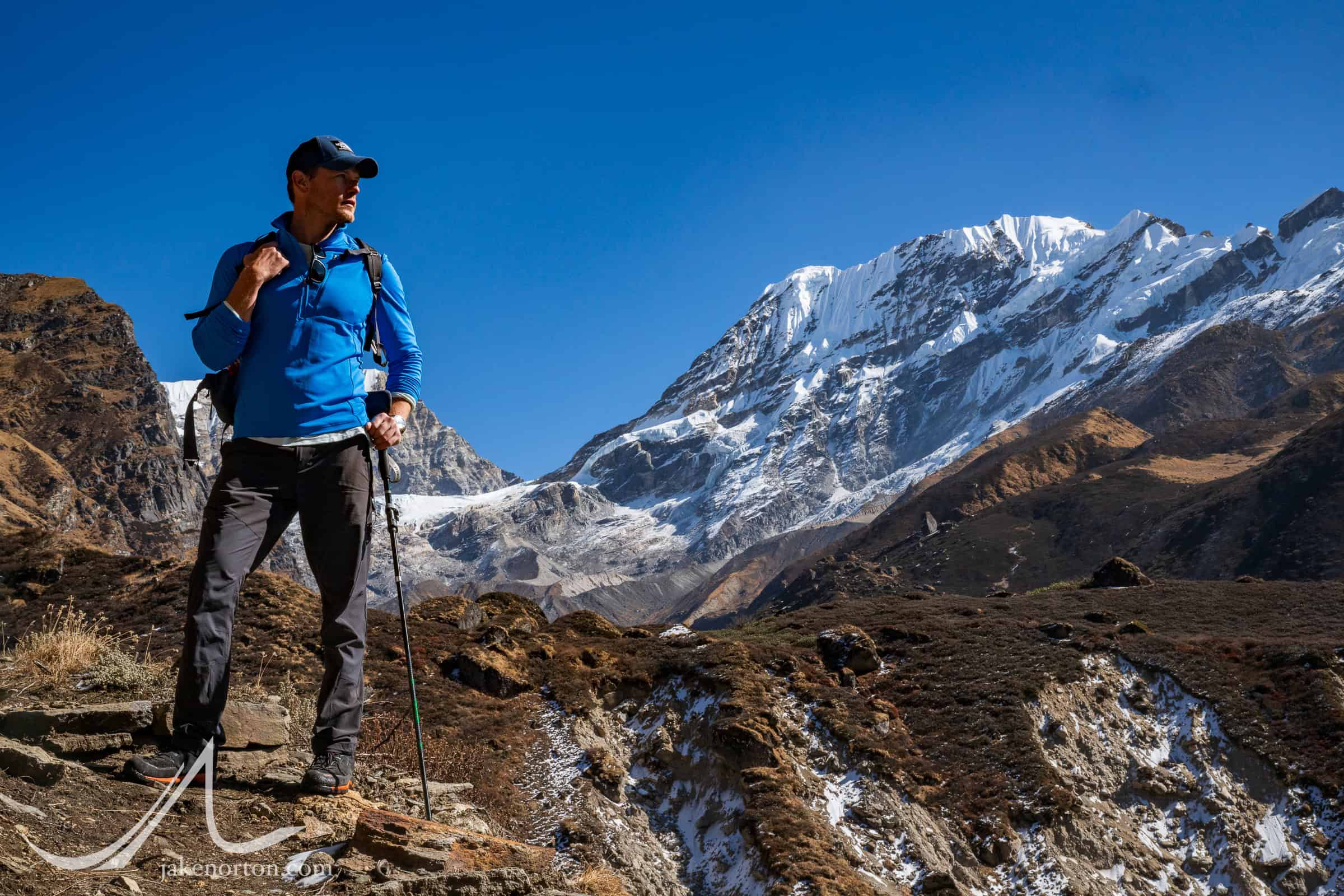
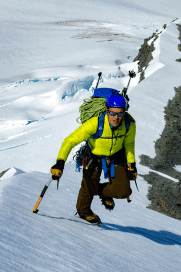

You amaze me every time I read your writing. You put us on the trails along with you. Thank for you sharing your adventures and your love for Nepal and its people.
Fabulous! I especially love your encounter with Gelu. Old-fashioned entrepreneurship, and lovely hospitality, too.
🙏 thank you for sharing your journeys…your words and actions change the world.
Beautifully written.Exciting to follow you Mr Norton.
A climber with a talent for writing is a gift to all who discover them. My brother, now Wolverine’s publisher, was a writer, photographer, and editor for Climbing Magazine for years, so I recognize and appreciate your gift accordingly. I found you through Sam, as have many, but it also feels like a homecoming for me. Thank you for sharing this trek so eloquently.
Thank you Jake, for sharing more of your journey. The way you describe every move, I feel like I am there with you. 15,750 feet, I can see where the altitude can plays tricks on your mind, and the stress on the body must be tremendous.
What an amazing adventure! Thank you so much for sharing and painting such vivid scenes and images from this trip! Can’t wait for part 3!
Earth is a beautiful planet worth exploring, revealing its secrets to the sensitive eyes of travelers. Thank you for sharing your sensitivity. 🙏🙌🤝
Such wonderful writing and feeling like we are on this journey with you . Thank you and for sharing 🙏 !
Your recap of this journey is amazing. I feel as though I am right there experiencing every moment. Can’t wait to hear Part 3.
Your words of your team’s adventure are enthralling! I’m learning so much! It is quite incredible and such a pleasure to follow. Pics are absolutely breathtaking & not surprised at all with Sam’s enthusiasm & love of exploring! Thanks again! Rae
I agree with Alex. Love how you share. You bring us in a lovely way. Love seeing the trip through your eyes!!!Thank you
And thanks for taking such good care of Sam
Amazing narative I really enjoyed your writing and look forward to next.
Thank you for sharing this amazing adventure. Thank you for helping our dear MPC coach Sam make his dream come true. Thanks for the stunning pictures. Can’t wait to read and see more of this adventure!
As eloquent as always, Jake. Thanks for bringing us along on your fabulous adventure.
What a wonderfully detailed account!Your descriptions and photos provide a surprisingly immersion, vicarious experience to this reader! Thank you!
What a wonderfully detailed account!Your descriptions and photos provide a surprisingly immersive, vicarious experience to this reader! Thank you!
Tbh so curious to hear… what do u do if you do cross path with a leopard? What’s necessary to do to remain safe?
Truly grateful for your wonderfully eloquent, informative detailed summary. Thank you Jake so much
Thank you for sharing this vivid description of the first part of the trek that you, Sam and your team recently shared together. I’ve been trying to picture the trail in my mind and your writing and pictures helped to bring it to life. Amazing! I came to your website as a follower of Sam but soon realized that I had already seen much of your work about Everest, George Mallory etc. quite a while ago. Happy to have found and supported your website. Keep the adventure stories coming for this vicarious explorer.